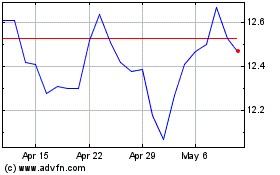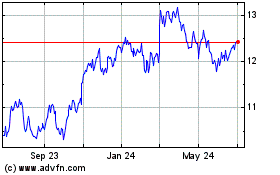By Zeke Turner
FRANKFURT -- Book publishers are giving an advance review of the
industry's future, and it looks a lot like the past.
After a decade of technological upheaval and lackluster growth,
executives at the top four U.S. consumer book publishers say they
are done relying on newfangled formats to boost growth.
It has been nearly 10 years since Amazon.com Inc. introduced its
Kindle e-book reader amid the financial crisis, destabilizing
publishers and challenging their well-honed business models.
Now, e-book sales are on the decline, making up a fraction of
publishers' revenue, and traditional book sales are rising. The
consumer books industry is enjoying steady growth in the U.S., with
total revenue increasing about 5% from 2013 to 2016, according to
the Association of American Publishers.
Executives gathered in Frankfurt for the industry's biggest
trade fair said they are returning to fundamentals: buying and
printing books that readers want to buy -- and they are
streamlining their businesses to get them out faster than ever
before.
It is about "knowing what [readers] want," said Markus Dohle,
chief executive of Bertelsmann SE and Pearson PLC's joint venture
Penguin Random House, "to drive demand at scale."
The shift is a surprise reversal for an industry that experts
just a decade ago predicted was facing radical change, if not a
slow death, because of digitization and changing reading habits.
Instead, e-book sales in the U.S. were down about 17% last year,
according to the AAP industry group, while printed book revenue
rose 4.5%.
Interviews at the Frankfurt Book Fair with the top four consumer
book publishers in the U.S. -- Penguin Random House, CBS
Corporation's Simon & Schuster Inc., Lagardère SCA's Hachette
Livre and News Corp's HarperCollins Publishers -- showed the decade
of seeking cover from outside threats is over, but the fight to
overcome the lackluster growth it left behind has just begun.
One thing all agree on is the need for speed. Companies are
reinvesting in printed books after years of cost-cutting, and they
are building pipelines to bring author's words into readers' hands
faster.
The effort has been spurred on by the success of books that
resonate with the political moment such as HarperCollins's
"Hillbilly Elegy," by J.D. Vance, about rural American culture and
Penguin Random House's "Devil's Bargain," by Joshua Green, about
former White House chief strategist Steve Bannon.
HarperCollins is printing two million copies of "Hillbilly
Elegy," CEO Brian Murray said, after an initial pre-election print
run of just 15,000 copies. "Everyone on the coasts wanted to know
how Donald Trump got elected...and to understand the view from the
heartland of America," Mr. Murray said. HarperCollins, like The
Wall Street Journal, is owned by News Corp.
Mr. Murray blamed flagging e-book sales on "screen fatigue," and
said HarperCollins was upping investment in printed books, "the
value anchor" for the entire business.
Printed books are "more beautiful now," he said. "You'll see
endpapers [and] a lot more design sensibility going into the print
editions because we recognized that they can't be throwaway."
When Simon & Schuster published the hardback edition of
Hillary Clinton's "What Happened" last month, it sold 167,000
copies in its first week, more than any hardcover nonfiction book
since 2012, according to the company and NPD Bookscan data. CEO
Carolyn Reidy said a million copies would ship by the end of the
year.
And after years "spent taking pennies out of the cost of making
a book," the company is raising the quality of its print editions
again, she said. As examples, the company cited last year's
"Principles," by Bridgewater Associates founder Ray Dalio, and
Walter Isaacson's " Leonardo da Vinci," out in hardcover next
week.
Publishers say the quickening pace of politics, especially in
the U.S., has made speed all the more crucial.
"Previous presidents moved more slowly," said Eric Nelson,
executive editor for the Harper imprint of HarperCollins. "You
could write to where you'd think the political world would be in a
year and likely be correct. Now, you could spend an entire chapter
on a prominent political figure in President Trump's administration
and that person could be gone by the time the book comes out."
Next January, Harper is expected to publish "Trumpocracy: The
Corruption of the American Republic," by David Frum, a former
speechwriter for President George W. Bush. Mr. Nelson said the book
deal was signed in May and will be in the stores eight months later
-- more than twice as fast as the company's standard.
Penguin Random House, the world's biggest book publisher,
already has a title in the works on the 2018 midterm elections. The
publisher declined to comment on the specifics of the deal.
Political books are in high demand in Europe, too, said Arnaud
Nourry, the CEO of Lagardère SA's Hachette Livre, citing the
success last year of "Un president ne devrait pas dire ça,"
(translated as "A President Should Not Say Things Like That"), by
Gérard Davet and Fabrice Lhomme, based on five years of interviews
with former French President François Hollande.
In France, Hachette makes about 9% of its revenue from digital
sales because of national rules limiting discounts on the price of
e-books, Mr. Nourry said. In the U.S., they have stabilized at
about one-fifth of the big four publishers' revenue.
Simon & Schuster's Ms. Reidy said a young generation of
internet natives has been turning to print books -- a trend she
noticed when her company signed a deal with Rupi Kaur, a poet based
on Instagram, to sell and distribute her work in the U.S.
Her young fans "don't want the e-book at all. They want the
physical object," Ms. Reidy said. "They want to own something that
is connected to the person they like online and, number two,
because they can share it."
Jeffrey A. Trachtenberg contributed to this article.
(END) Dow Jones Newswires
October 14, 2017 08:39 ET (12:39 GMT)
Copyright (c) 2017 Dow Jones & Company, Inc.
Pearson (NYSE:PSO)
Historical Stock Chart
From Mar 2024 to Apr 2024

Pearson (NYSE:PSO)
Historical Stock Chart
From Apr 2023 to Apr 2024
